Measurement Man |
Pumpkin Activities |
Symmetric Faces |
Coordinate Graphing |
Student Work |
Literature |
Problem Solving


Fall into Math



Measurement Man
Students typically have difficulty in class and on testing with measurement topics. Consider sprinkling measurement instruction over the course of the year so that students have a chance to use the measurement units and to become more familiar with these units.
Measurement Man is a great hands-on activity as students assemble the pieces which build on student experience with cut-paper fractions. Students are able to visualize the relationship among these different units of capacity as they cut and assemble the figure. While they can't bring Measurement Man into testing, many students can see him in their mind which helps them visualize the units more clearly. Some teachers also encourage students to view their own arms and legs as quarts and pints. They just need to remember that they only have four fingers or toes on each hand and foot. Maybe the crows got one?
 Measurement Man directions are attached for your reference. Consider adding a pointed cap and some raffia straw to create a field of scarecrows, just perfect for fall.
Measurement Man directions are attached for your reference. Consider adding a pointed cap and some raffia straw to create a field of scarecrows, just perfect for fall.
See picture of Measurement Man Scarecrow
Scarecrow Glyphs: Check out the links for directions for scarecrow glyphs.
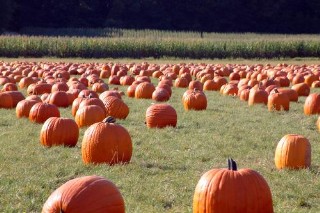
Pumpkins, Pumpkins Everywhere
Make the most of seasonal pumpkins by building in some math measurement experiences. Be sure to include an estimating experience first.
- Huge Pumpkin Estimation Station: Place a very large pumpkin in a central school location (e.g. Media Room or a display case near the office). Challenge students to estimate the size of the pumpkin. They should cut a piece of string that would just fit around the widest part of the pumpkin. After every student has "guesstimated" and cut a piece of string or yarn, allow students to place their string pieces around the widest part of the pumpkin. Create a display of pieces that were too long, too short or "just about right."
- Small Student Pumpkins: These can also be sorted by having students measuring around the widest part of the pumpkin and then arranging the strings on a class poster from shortest to longest. Label each child's name and the class has created a meangingful bar graph with information from their own small pumpkins. Students may also estimate which pumpkin is heaviest, then actually weigh the pumpkins to check.
- Class Pumpkin: Students should guess how many seeds they will find in the pumpkin when it is hollowed out. They can add to their number sense conceptual understanding by sorting these into groups of ten for counting. Students may cut strings to estimate the size around this pumpkin if a larger school pumpkin is not available. Sort the strings as described above.
- Jack-o-Lantern Glyphs: Check out the links for directions for two different jack-o-lantern glyphs.

Symmetric Faces
Halloween masks become a math activity when students create Symmetric Faces. See Symmetric Faces in the Geometry Section for directions to make these unique masks using 1.5 sheets of construction paper, scissors and glue.
Be sure to check out the Symmetric Faces Photo Gallery for pictures of symmetric faces to get your creative juices flowing.
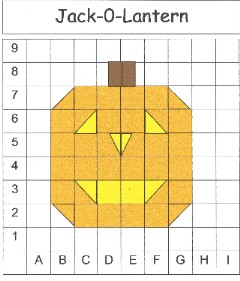
Introduction to Coordinate Graphing
Introduce elementary students to coordinate graphing through seasonal coloring activities. The fall Jack-O-Lantern activity requires students to use the grid code and crayons or markers to create a jack-o-lantern on a blank 9x9 grid. The use of letters on the horizontal axis and numbers on the vertical axis introduces young students to coordinate pairs without the confusion of the standard (h,v) format. Notice that it is important that elementary students become accustomed to listing the horizontal coordinate first as this will transfer to the Cartesian coordinates they will use in later grades.
Download the  Jack-O-Lantern coordinate graphing activity
Jack-O-Lantern coordinate graphing activity
Student Work: Seasonal Math Activities
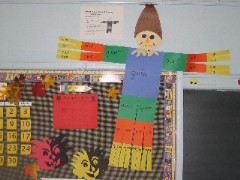
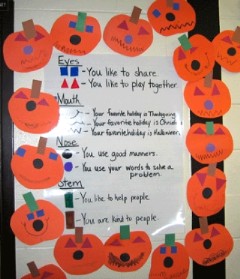
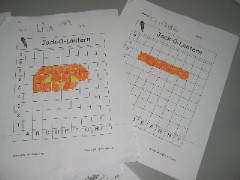
Scarecrow "Measurement Man," pumpkin glyphs and Jack-o-Lantern Coordinate Graphs are examples of seasonal math activities that provide seasonal decorations while developing understanding of important mathematical concepts.
What do scarecrows like to eat for breakfast? "Straw" - berries
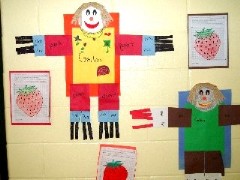
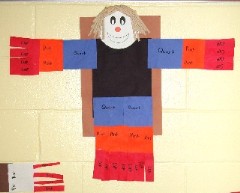
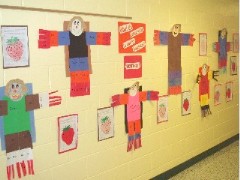
Mrs. Thal's fifth graders at Sycamore Drive School in Hazlet, NJ, made measurement man scarecrows to decorate the halls and learned a bit about measurements in the process.
Symmetric Pumpkin Challenge
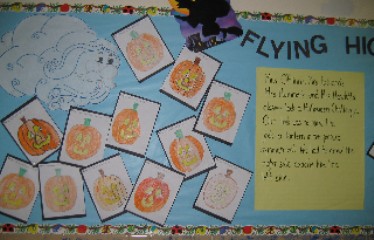

Mrs. O'Flinn's, Mrs. Fabiano's, Mrs. Hummer's and Mrs. Howlett's classes took the Halloween Challenge. These third grade students at Joseph C. Caruso School in Keansburg, NJ, had to make the jack-o-lantern in the picture symmetrical. Students were challenged to draw in the right side to make a mirror image of the left side. Download the Symmetric Pumpkin template [PDF]
Name-Collection Spiders
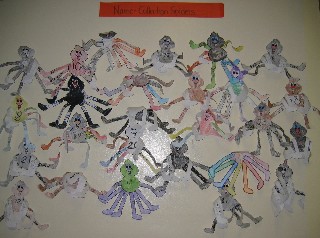
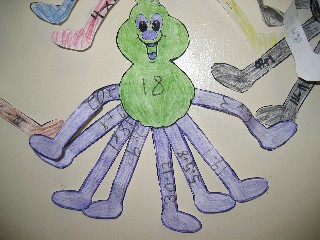
Ms. Collier's and Ms. Rachko's classes created Name-Collection spiders for Halloween. These fourth grade students at Joseph C. Caruso School in Keansburg, NJ, extended the Everyday Math name-collection box routine to writing 8 different names for each number, one for each spider leg.
Halloween Glyphs
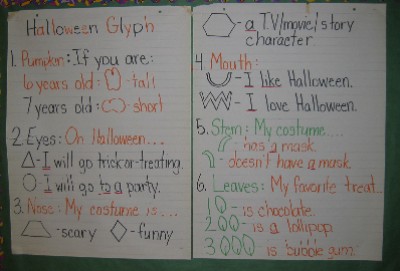
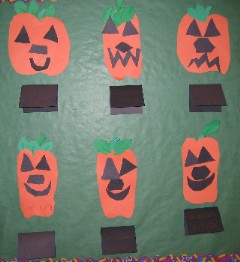
Mrs. Bestle's first graders at Port Monmouth Road School in Keansburg, NJ, created pumpkin glyphs. Students had to read the legend then decide which shapes they needed to create their pumpkin glyphs. Black construction paper squares below each Halloween glyph asked "Who Am I?" to encourage students to interpret the glyphs and decide which classmate had made each glyph. After guessing, students could lift the flap to check the name.
Pumpkin Measurements
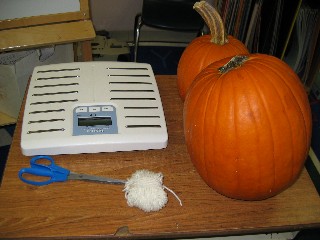

Students in Mrs. Annuzzi's first grade at Port Monmouth Road School in Keansburg, NJ, enjoyed a pumpkin measurement lesson prepared by their student teacher, Ms. Davidson. Students estimated the weight of two pumpkins then actually weighed them on the scale. The first graders used string to measure the "girth" of the pumpkins and posted their strings on the board for reference.
Turkey Glyphs
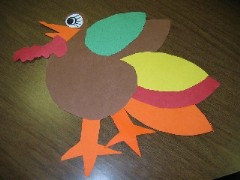
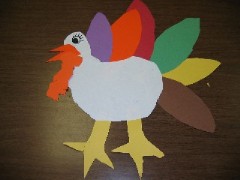
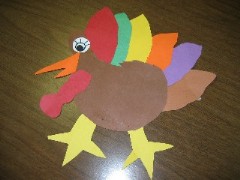
Students in Mrs. Bestle's first grade created turkey glyphs that tell a story about how they celebrate Thanksgiving and what foods they like to eat on that special day.

Literature Connections
The Biggest Pumpkin Ever by Stephen Kroll would be a great literature connection for the Huge Pumpkin Estimation Station discussed above or to introduce the class pumpkin sorting activity.
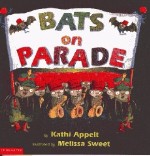
Bats on Parade by Kathi Appelt is a literary introduction to square numbers and the patterns they form as square arrays. The bats march in parade formation and different sections of the band, being different sizes, march in different arrays: "In nine rows of nine those trombones reported, while there, right behind them, the tubas retorted." The pictures and rhyme reinforce the mathematics of the patterns and teachers can easily ask students to predict how many bats will be in the next section or ask them to figure out how many bats are in the whole band before reading those pages. Add this book to your collection of problem-solving literature prompts.
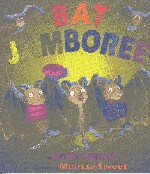
Bat Jamboree by Kathi Appelt introduces the triangular number pattern as bats assemble for the final number beginning with 10 bats in the bottom row, 9 in the next row, etc. to the very top row with 1 bat. Students are introduced to the 55 bats in formation and their various acts but the book "isn't over until the bat lady sings." Students will enjoy this introduction to an important mathematical pattern. Teachers can find many problems that build upon this triangular number pattern and extend the experience. Look for several penguin problems in the Winter Math Activities that will be available on November 1st. This set of problems builds on the triangular pattern and is sequenced to develop student understanding of the pattern and student use of appropriate tables and charts to organize and record data.
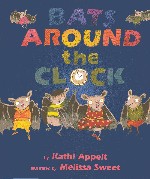
Bats Around the Clock by Kathi Appelt takes a humorous dance through time. Click Dark and American Batstand introduce a new dance each hour. Students move through time, enjoy some rhyme and learn the names of some oldie-but-goodie dances along the way.

Pumpkin Problem Solving
 Virtual Pumpkin Carving site: can you carve a symmetric pumpkin? [online activity]
Virtual Pumpkin Carving site: can you carve a symmetric pumpkin? [online activity]
 Carve Your Own Virtual Pumpkin allows you to design a jack-o-lantern from an array of choices for eyebrows, eyes, noses and mouth. This could easily become a discrete math lesson on combinations for older students who should be challenged to see if everyone in the class could make a different pumpkin (i.e. not all features alike on any pumpkin). If there are 7 choices for each eyebrow, 15 choices for each eye, 8 choices for a nose and 7 choices for a mouth, will everyone in the class be able to make a different jack-o-lantern? Could everyone in the school make a different jack-o-lantern? How many different jack-o-lanterns are possible? You'll need a calculator for this one!
Carve Your Own Virtual Pumpkin allows you to design a jack-o-lantern from an array of choices for eyebrows, eyes, noses and mouth. This could easily become a discrete math lesson on combinations for older students who should be challenged to see if everyone in the class could make a different pumpkin (i.e. not all features alike on any pumpkin). If there are 7 choices for each eyebrow, 15 choices for each eye, 8 choices for a nose and 7 choices for a mouth, will everyone in the class be able to make a different jack-o-lantern? Could everyone in the school make a different jack-o-lantern? How many different jack-o-lanterns are possible? You'll need a calculator for this one!
- Jack-o-Lantern Combinations for Younger Students: Consider modifying this to a smaller problem for younger students by omitting some choices: Use 2 choices for eyes, 2 choices for noses and 2 choices for mouths. If each option is a different color or shape, small groups can draw pictures of the different combinations and see that there would be a total of 8 different combinations. Challenge student groups to find all of them. Provide Ellison machine pumpkin cutouts to each small group so that students can draw different eyes, noses and mouths to create the different combinations.
- Download
 Jack-o-Lantern Combinations problem, student worksheet and solution.
Jack-o-Lantern Combinations problem, student worksheet and solution.
- Download
- Halloween Signboard and TrickTreat Signboard encourage students to look for patterns in repeating letters to figure out which letter will be the 100th letter to be repeated on the signboard. Students may use division and remainders, skip counting or repeated addition to solve the problems, making them accessible to students in many grades. Each problem includes a challenge to extend the problem-solving experience and a possible solution.
- Download
 Halloween Signboard
Halloween Signboard
- Download
 TrickTreat Signboard
TrickTreat Signboard
- Download
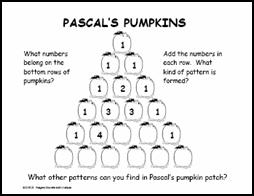
- Pascal's Pumpkins encourages students to look for patterns in Pascal's Triangle. The handout develops awareness of this important mathematical pattern through this timely seasonal activity. Students who take higher math courses will meet Pascal again in many different applications, including probability. This handout is an outgrowth of the Rutgers Discrete Math Institute.
- Download
 Pascal's Pumpkins problem and answer key.
Pascal's Pumpkins problem and answer key.
- Download
- How Many Ghosts Do You See? encourages students to apply the patterns in Pascal's Triangle. A teacher instructional plan with mathematical background, answer and challenge is included to explain how to present this problem which is also an outgrowth of the Rutgers Discrete Math Institute. A recording sheet was also included as part of the teacher packet so that students are able to record all different solutions in a "systematic" way, which is a goal of discrete mathematics.
- Download
 Pascal's Ghosts problem, instructional plan, student recording sheet and answer key.
Pascal's Ghosts problem, instructional plan, student recording sheet and answer key.
- Download

Links to Additional Activities on the Internet
 Fall Math Idea Bank at Mathcats offers directions for making symmetric spiders, geometric spider webs, symmetric leaves and many other fall math activities.
Fall Math Idea Bank at Mathcats offers directions for making symmetric spiders, geometric spider webs, symmetric leaves and many other fall math activities.
 Halloween Math Activities from Scholastic include Mystery Mansion for some Halloween multiplication practice.
Halloween Math Activities from Scholastic include Mystery Mansion for some Halloween multiplication practice.
 Do Vampires Really Exist? is a problem-solving activity that promises middle school students that mathematics can answer the age-old question. Students begin with the premises that there is one vampire somewhere in the world, that a vampire must suck the blood of one person per week to stay alive, and that once bitten, that person also becomes a vampire. Students use a spreadsheet to study the increasing pattern and analyze the results to answer the question. This Microsoft Education lesson plan would surely capture the imaginations of adolescents while providing some mathematical basis for analyzing the growth pattern of a non-linear function.
Do Vampires Really Exist? is a problem-solving activity that promises middle school students that mathematics can answer the age-old question. Students begin with the premises that there is one vampire somewhere in the world, that a vampire must suck the blood of one person per week to stay alive, and that once bitten, that person also becomes a vampire. Students use a spreadsheet to study the increasing pattern and analyze the results to answer the question. This Microsoft Education lesson plan would surely capture the imaginations of adolescents while providing some mathematical basis for analyzing the growth pattern of a non-linear function.